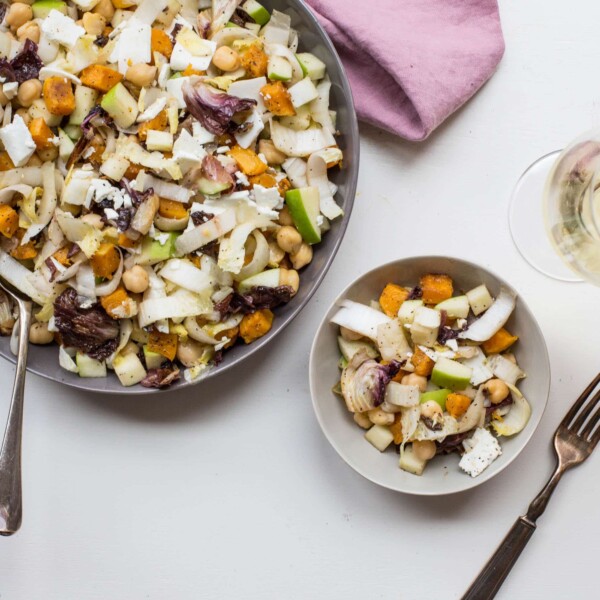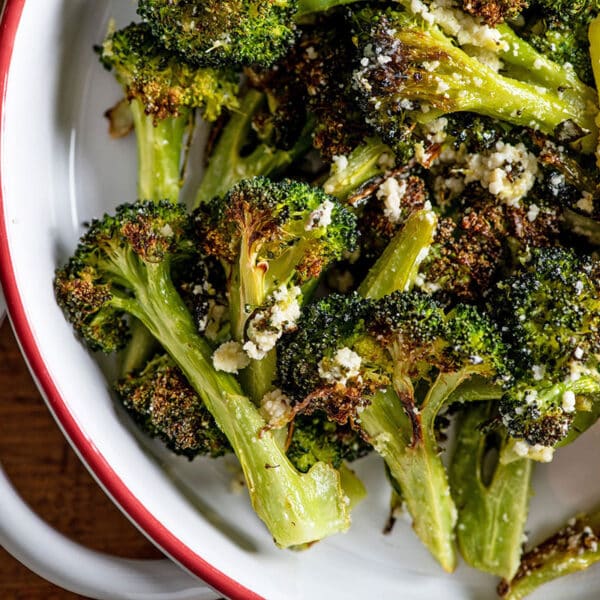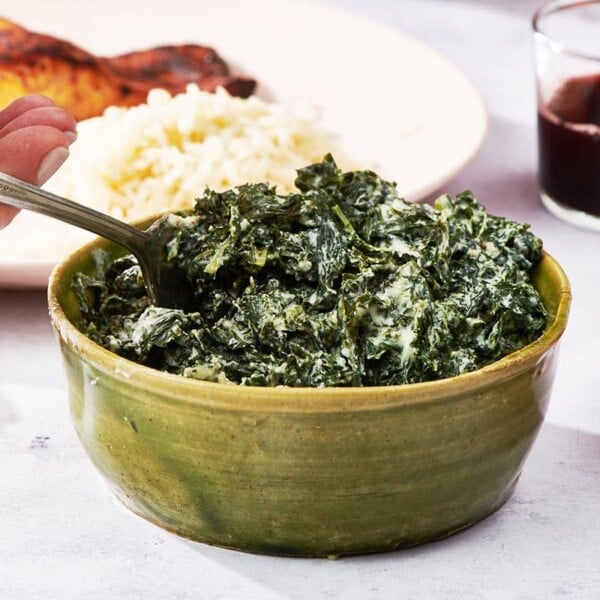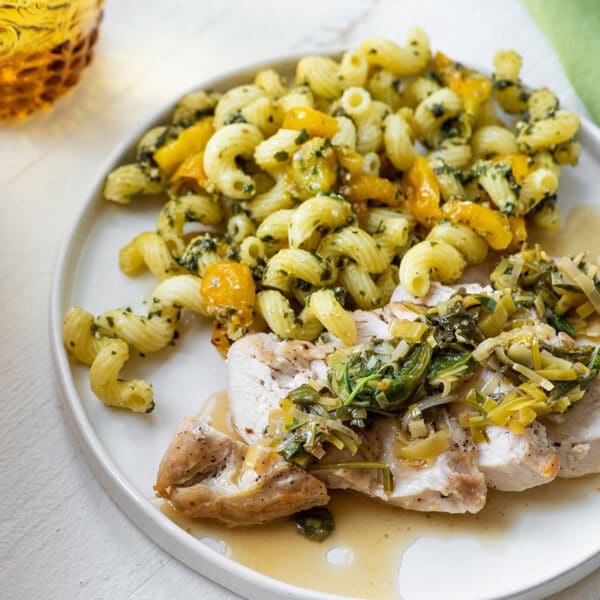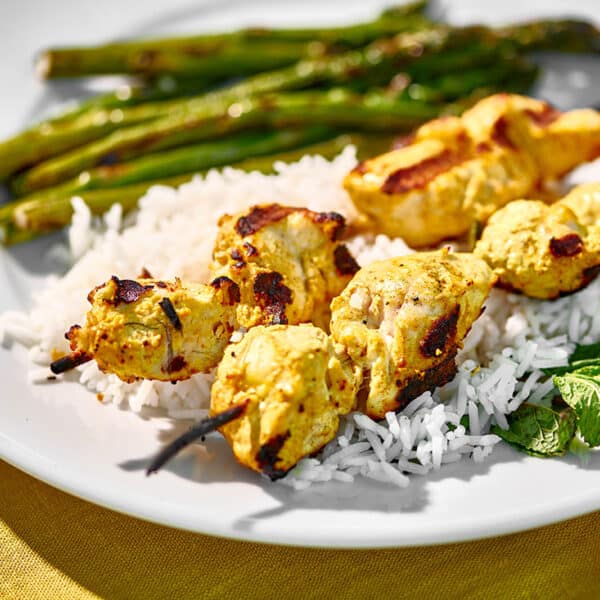Coq au Vin
on Oct 24, 2021, Updated Nov 03, 2024
This post may contain affiliate links. Please read our disclosure policy.
Coq au vin is the classic red wine braised chicken dish that embodies the best of rustic French cooking.
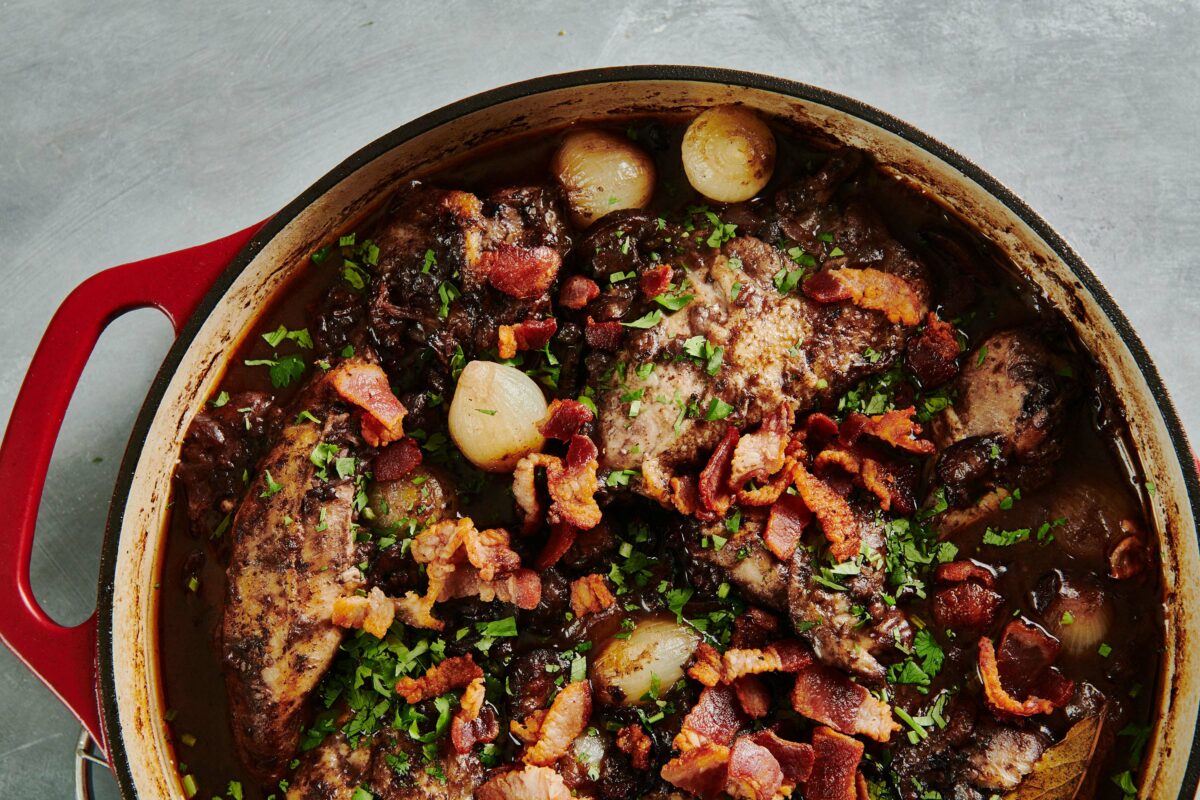
If there is a more classic French stewed/braised chicken dish, I don’t know it. It’s one of those quintessential dishes that has well deserved its place in the French culinary lexicon.
To complete your French feast, serve Coq au Vin with Roasted Carrots, Green Beans with Tarragon Vinaigrette, or Romaine, Pear, and Goat Cheese Salad, and of course, a glass of red wine.
By signing up, you agree to our Privacy Policy.
What's In This Post?

Coq au vin is the classic red wine braised chicken dish that embodies the best of rustic French cooking. Serve over your favorite starch!
What Is Coq au Vin?
Coq au vin, translated simply means chicken with wine, and at its core, that is exactly what this dish is. It usually contains pearl onions and mushrooms as well, and often garlic or shallots (or, in this case, both!).
I perused a dozen coq au vin recipes and tested away to get to my version, which takes a little bit of inspiration from a lot of places.

Coq au Vin Ingredients
- Thick-cut bacon – The bacon is crisped up into lardons, and then the chicken is browned in the bacon fat, which ups the level of flavor.
- Chicken – Cut into pieces.
- Salt and pepper – To taste.
- Pearl onions – Pearl onions can be a pain to peel, but if you blanch them in a pot of boiling water for about 2 minutes and plunge them into an ice bath, the peel will practically slip off.
- Mushrooms – Any type of mushroom will work and offer a rich umami taste and variety of texture.
- All-purpose flour – For thickening.
- Olive oil – For cooking.
- Shallots and garlic – These aromatics offer a depth of flavor.
- Tomato paste – For richness and a subtle acidic note.
- Red wine – This provides the main flavors, so use one that you like; check out the note below for more.
- Chicken broth – Any type will work, but I opt for low-sodium broth.
- Thyme and bay leaf – These are classic French stew herbs.
- Unsalted butter – For creating richness and silkiness in the sauce.
- Chopped fresh parsley – For a pop of freshness.
- Egg noodles, mashed potatoes, or other starch – To serve.
What Kind of Wine in Coq au Vin
Really, many red wines work in this dish, and this dish will take on the flavor of the wine you use, so sample it to make sure you are all in. Julia Child recommends a “young, full-bodied red wine, such as Burgundy, Beaujolais, or Cotes du Rhone.” Richard Grausman, in his book French Classics Made Easy, also suggests a full-bodied red such as Pinot Noir, Cotes-du-Rhone, or Zinfandel. Chianti is another option.
In short, there are a lot of wine options to explore — pick one that you like to drink. (And have an extra bottle or two of that wine to serve with the meal — the original bottle will still have a glass left for you to sip while you make dinner!)

How to Make Coq au Vin
- Cook the bacon: In a large, deep skillet with a lid over medium heat, heat oil and add the bacon. Cook until bacon is crisped and remove onto a paper towel-lined plate.
- Brown the chicken: In the pan with the bacon grease over medium-high heat, add the chicken skin-side down. Brown the chicken on both sides. Transfer the chicken to another plate.
- Cook the vegetables: Add the olive oil to the pan, then add the shallots and cook until soft, then add the garlic and cook. Add the pearl onions and mushrooms and sauté until golden brown. Add the flour and stir until it coats the vegetables. Transfer to the chicken plate.
- Prepare the braising liquid: To the pan, add the tomato paste, red wine, broth, thyme, and bay leaf. Bring to a boil over medium-high heat, scraping the browned bit from the bottom of the pan into the liquid.

- Combine and cook: Return the chicken and vegetables to the pan, nestling the chicken into the vegetables so that the pieces rest on the bottom of the pan. Cover, lower the heat, and cook for another 35 minutes until the chicken is cooked through.
- Reduce the sauce: Use a large, slotted spoon to remove the chicken, mushrooms, and pearl onions from the pot and place them in a shallow serving bowl. Leave the liquid in the pot over medium heat and simmer until it reduces by about one-third. You can strain the liquid at this point or keep the pieces in. Add the butter, stirring until it’s melted.
- Finish: Pour the sauce over the chicken and vegetables. Sprinkle the bacon and parsley over the top of the chicken.

Storage and Reheating
Coq au Vin can be fully prepared up to two days in advance. Bring it to room temperature and reheat it on the stove over medium-low heat for about 20 to 25 minutes or in a preheated 350-degree F oven for about 30 minutes before serving. If it is being heated straight from the fridge, you’ll want to add another 15 to 20 minutes to the heating time.
What to Serve with Coq au Vin
Coq au Vin is traditionally served with some sort of starch to soak up all of those winey, flavorful juices. Try egg noodles, mashed potatoes, farro, quinoa, or rice, and with or without these items, it’s always a good idea to pass around a loaf of crusty bread for mopping the plate.

More Comfort Food Chicken Recipes:
- Chicken and Dumplings
- Chicken Pot Pie
- Spinach and Feta Stuffed Chicken Thighs
- Easy General Tso’s Chicken
Pin this now to find it later
Pin It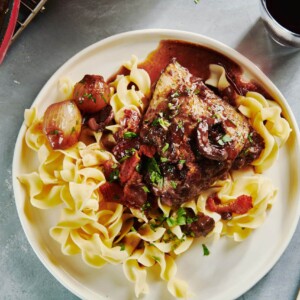
Coq au Vin
Ingredients
- 4 strips thick-cut bacon (sliced crosswise)
- 1 (3- to 4-pound) chicken (cut into eight pieces or 3-4 pounds chicken pieces)
- ½ teaspoon kosher salt
- ¼ teaspoon freshly ground black pepper
- 20 pearl onions (approximately; peeled)
- 8 ounces mushrooms (any kind) (wiped clean and halved)
- 2 tablespoons all-purpose flour
- 1 tablespoon olive oil
- 3 large shallots (chopped)
- 1 tablespoon minced garlic
- 1 tablespoon tomato paste
- 3 cups full-bodied red wine
- 1 cup chicken broth (preferably less-sodium)
- 2 sprigs fresh thyme (or 1/2 teaspoon dried thyme)
- 1 bay leaf
- 2 tablespoons unsalted butter
- 2 tablespoons chopped fresh parsley
- Egg noodles, mashed potatoes, or other starch (to serve; optional)
Instructions
- Heat a large, deep skillet with a lid over medium heat, and add the bacon. Line a plate with paper towels. Cook, stirring frequently, until the bacon is browned and crisped. Remove with a slotted spoon to the paper towels, and leave the fat in the pan.
- Return the pan to medium-high heat and add the chicken, skin side down. Brown the chicken on both sides, about 15 minutes in total. Then transfer the chicken to another plate.
- Add the olive oil to the pan, then add the shallots and cook over medium heat for 3 minutes until they start to soften. Then add the garlic and cook, stirring, for one more minute until you can smell the garlic. Pour off almost all the fat from the pan, then return it to medium heat. Add the pearl onions and mushrooms, and sauté for 5 minutes, until the vegetables are golden and any juices that the mushrooms have released evaporate. Add the flour and stir until it coats the vegetables. Cook, stirring for 1 more minute. Transfer the vegetables to the plate with the chicken.
- The bottom of the pan will probably have a lot of golden bits and pieces stuck to it, which is not only ok but desirable. Add the tomato paste, red wine, broth, thyme, and bay leaf. Bring to a boil over medium-high heat, scraping the browned bit from the bottom of the pan into the liquid.
- Return the chicken and vegetables to the pan, nestling the chicken into the vegetables so that the pieces rest on the bottom of the pan. Cover the pan, lower the heat so that the mixture is at a gentle simmer, and cook for another 35 minutes until the chicken is cooked through. Baste with the cooking liquid occasionally as you go.
- Use a large, slotted spoon to remove the chicken, mushrooms, and pearl onions from the pot and place them in a shallow serving bowl. Some of the minced ingredients will come along with the onions, and that’s fine. Cover with foil to keep warm. Leave the liquid in the pot over medium heat and simmer until it reduces by about one-third. At this point, you can strain the cooking liquid if you like a silkier, smoother sauce and return it to the pot, discarding the solids that are strained out or just leaving the sauce in the pot. Either way, add the butter, stirring until it’s melted. Taste and adjust the seasonings as needed.
- Pour the sauce over the chicken and vegetables, and serve with the starch of your choice. Sprinkle the bacon and parsley over the top of the chicken. You can also plate the portions individually in shallow bowls if you like.
